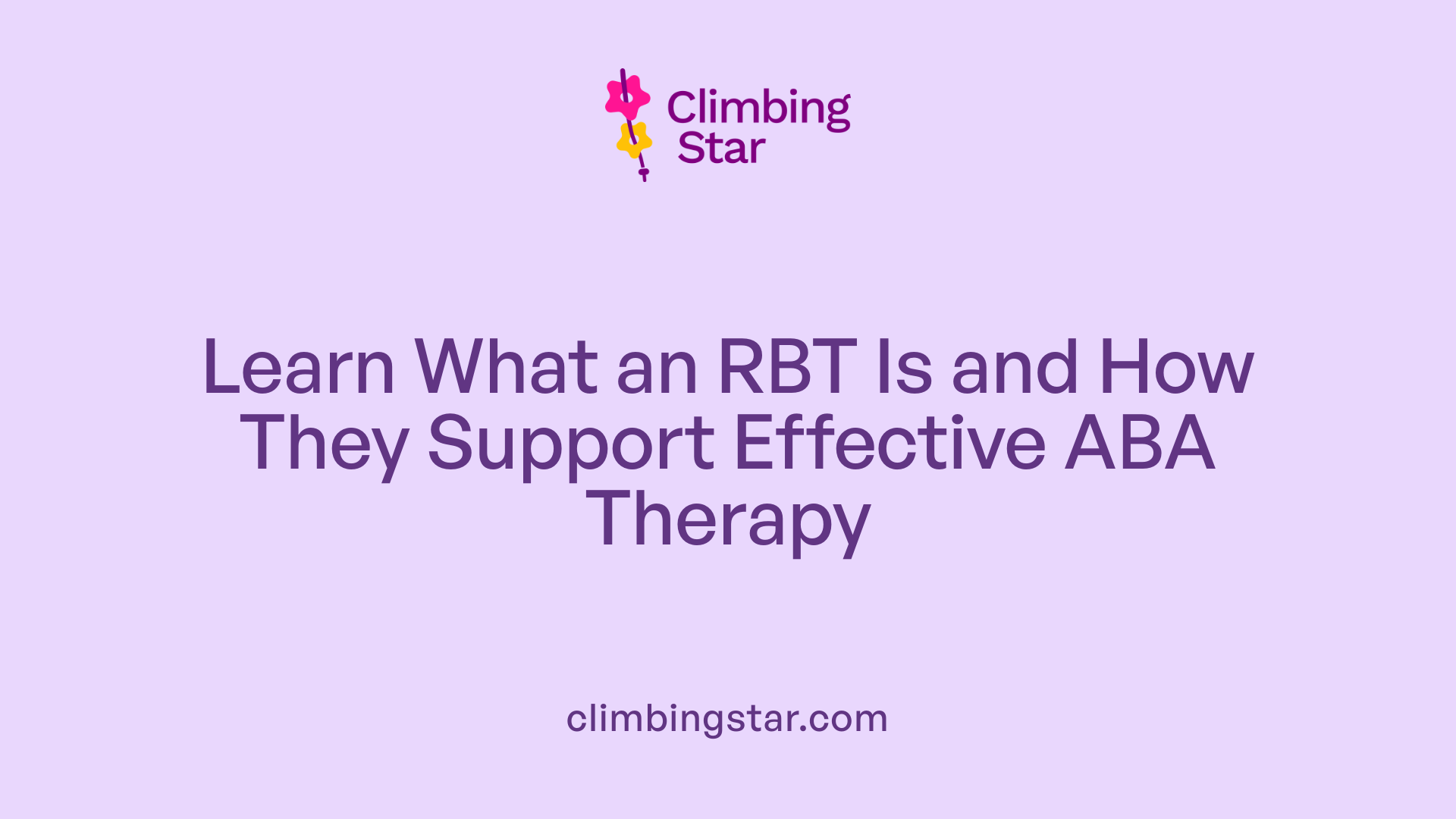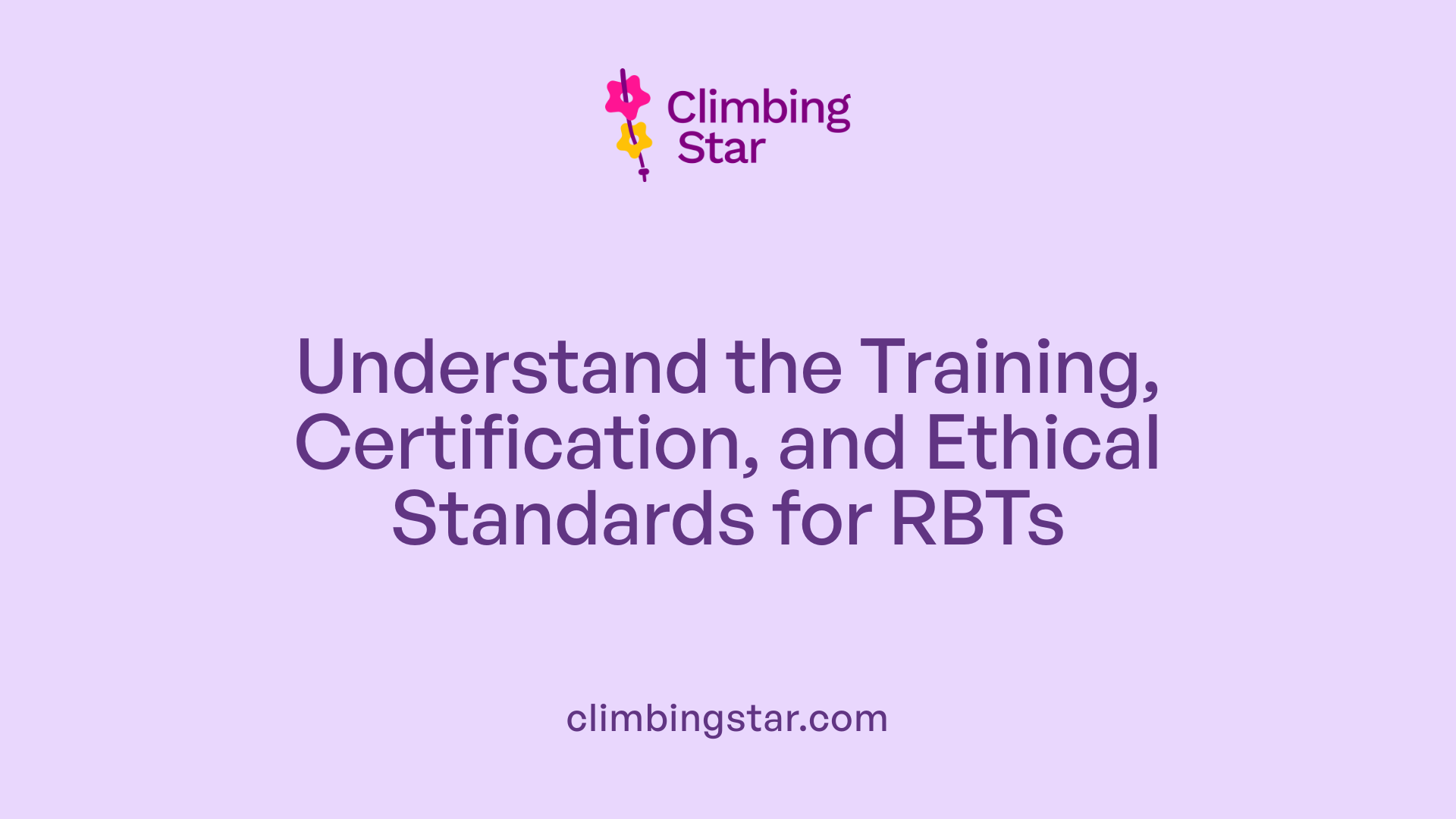Introduction to Registered Behavior Technicians (RBTs)
In the evolving landscape of autism therapy, Registered Behavior Technicians (RBTs) have emerged as vital practitioners on the front lines of Applied Behavior Analysis (ABA) therapy. Working closely under the supervision of highly trained Board Certified Behavior Analysts (BCBAs), RBTs deliver hands-on, direct behavioral interventions to support individuals with autism. This article explores the essential functions, training, and contributions of RBTs within the framework of behavioral analysis therapy, highlighting their role in improving communication, social, and adaptive skills in children with Autism Spectrum Disorder (ASD).
What is an RBT and How Do They Support ABA Therapy?

Definition of Registered Behavior Technician (RBT)
An RBT, or Registered Behavior Technician, is a paraprofessional certified to work directly with individuals with autism. They deliver behavior-analytic services under supervision and help implement Applied Behavior Analysis (ABA) therapy programs focused on improving social, communication, and behavioral skills.
Relationship Between RBTs and Board Certified Behavior Analysts (BCBAs)
RBTs work under the guidance of BCBAs, who are highly trained professionals responsible for assessing behavioral issues and designing treatment plans. While BCBAs develop and oversee interventions, RBTs carry out these plans, collect data, and track progress to ensure effective therapy.
Overview of the RBT Certification Process and Requirements
To become an RBT, candidates must complete a 40-hour training program, demonstrate practical competency, pass a certification exam administered by Pearson VUE, and maintain certification with annual renewal, including continuing education and adherence to ethics standards. The BACB (Behavior Analyst Certification Board) governs these standards and ensures program credibility.
Typical Responsibilities and Work Settings for RBTs
RBTs implement structured behavioral interventions, focusing on skill development and behavior modification. Their work environments vary, including schools, homes, and community settings, allowing tailored support. Duties often include direct therapy, data collection, collaborating with families, and promoting consistency of therapeutic strategies across settings.
Role of RBTs in Supporting Behavior Analytic Services
In ABA therapy, RBTs play a vital role by working hands-on with clients to reinforce positive behaviors, enhance communication, and support social skills. They assist BCBAs through detailed data gathering and applying intervention plans, contributing significantly to helping individuals with autism achieve developmental milestones and improve their quality of life.
What is Applied Behavior Analysis (ABA) Therapy and How Does It Help Individuals with Autism?
ABA therapy utilizes learning principles like positive reinforcement to improve skills and reduce problematic behaviors. It is individualized and evidence-based, designed to strengthen communication, social abilities, and life skills in individuals with autism, enhancing their overall development and independence.
Training, Certification, and Ethical Standards for RBTs

Eligibility Criteria and 40-hour Training Program
To become a Registered Behavior Technician (RBT), candidates must first meet eligibility requirements including a minimum age and background checks. They are then required to complete a comprehensive 40-hour training program that covers the fundamentals of Applied Behavior Analysis (ABA), behavior intervention techniques, and data collection methods.
Competency Assessments and Certification Exam
Following training, candidates undergo competency assessments to demonstrate their practical skills and understanding. Certification is finalized by passing the RBT exam administered through Pearson VUE, under the oversight of the Behavior Analyst Certification Board (BACB). This process ensures RBTs possess the knowledge and capabilities to deliver quality behavior-analytic services.
Annual Certification Renewal and Ongoing Education
RBT credential holders must renew their certification annually. This includes continuing education to stay current with best practices and ethical standards. Renewal ensures that RBTs maintain their competence and can adapt to advances in behavioral therapy techniques.
Ethical Responsibilities and Standards Adherence
Ethics are central to the RBT role. Registered Behavior Technicians must adhere to rigorous ethical guidelines established by the BACB. These standards cover client dignity, confidentiality, professional conduct, and the proper delivery of interventions, safeguarding the welfare and rights of individuals receiving services.
Supervision Requirements by Qualified Professionals
RBTs always operate under the supervision of qualified professionals such as Board Certified Behavior Analysts (BCBAs) or BACB-certified supervisors. Supervisors oversee treatment planning, performance monitoring, and ensure that RBTs deliver interventions correctly and effectively.
Who Typically Provides Behavioral Analysis and Autism Therapy Services?
Behavioral analysis and autism therapy services are typically provided by trained professionals such as Board Certified Behavior Analysts (BCBAs), licensed therapists, and Registered Behavior Technicians (RBTs). These providers develop and deliver individualized treatment plans based on ABA principles. Services occur in clinical, educational, and home environments, involving direct therapy, family collaboration, and systematic assessment to support skill development and behavior management effectively.
Core ABA Techniques Implemented by RBTs to Enhance Communication and Behavior

What are the key components or techniques used in behavioral analysis therapy for autism?
Registered Behavior Technicians (RBTs) use several core ABA interventions to help individuals with autism improve behavior and develop new skills. Among the most common techniques are:
- Discrete Trial Training (DTT): This involves breaking down skills into small, teachable steps and teaching each step systematically.
- Natural Environment Teaching (NET): Skills are taught in everyday settings, using naturally occurring opportunities to encourage learning.
- Positive Reinforcement: RBTs reward desired behaviors to increase their occurrence, which is fundamental in behavior change.
- Prompting and Fading: RBTs guide clients to perform behaviors by prompting, then gradually reduce help to promote independence.
These methods work together to provide structured, consistent teaching tailored to each child’s needs.
How does behavioral analysis therapy improve communication skills in individuals with autism?
Improving communication is a central focus for RBTs working with ABA therapy. They support development in both verbal and nonverbal communication using:
- Modeling: Demonstrating desired communication behaviors for clients to imitate.
- Use of Augmentative and Alternative Communication (AAC): Tools like picture exchange communication systems (PECS), speech-generating devices (SGDs), and communication boards help clients express themselves.
- Prompting and Reinforcement: Encouraging attempts at communication by providing prompts and reinforcing successful communication efforts.
By systematically increasing functional communication and reducing communication barriers, RBTs help clients gain skills that enhance interaction and daily living.
What role do RBTs play in data collection and therapy adjustments?
An essential part of RBT responsibilities is collecting detailed data on client responses and behaviors during therapy sessions. This data helps in:
- Monitoring progress toward behavioral goals.
- Informing supervisors, such as Board Certified Behavior Analysts (BCBAs), in adjusting intervention plans.
- Ensuring therapeutic techniques remain effective and personalized.
Overall, the hands-on implementation of these core ABA techniques by RBTs is vital to meaningful improvements in communication, social skills, and behavior for children with autism.
The Importance of Early Intervention and Family Collaboration in ABA Therapy

What are the benefits of early intervention using behavioral analysis for children with autism?
Early intervention with Applied Behavior Analysis (ABA) therapy is vital for young children with autism because it taps into the brain's heightened ability to adapt during early childhood. By starting therapy as early as 6 to 12 months, RBTs can help children develop crucial social, communication, and cognitive skills.
Behavioral interventions at this stage use positive reinforcement to encourage desirable behaviors while reducing challenging ones. This not only fosters progress in language and adaptive behaviors but also improves independence over time.
How does early therapy influence developmental outcomes?
Early ABA therapy leads to improved developmental trajectories by promoting skill acquisition when the child's brain is most receptive. Children who receive timely intervention tend to perform better in communication, social interaction, and daily living skills.
RBTs play an essential role by implementing structured programs under BCBA supervision, providing consistent opportunities to practice new skills and behaviors in different settings.
How do RBTs promote skill generalization at home and in the community?
RBTs work closely with families to ensure therapeutic strategies extend beyond clinical sessions. They coach caregivers on practical ways to reinforce skills in everyday environments such as home and school.
This collaboration helps generalize learned behaviors across multiple contexts, increasing the likelihood that skills will sustain and expand.
How does collaboration between RBTs and families reinforce therapeutic strategies?
Combining RBT expertise with family involvement creates a supportive atmosphere that enhances therapy effectiveness. Families receive guidance on behavior management, communication techniques, and social skill development, facilitating consistent practice.
This partnership boosts confidence for both children and families, fostering a nurturing environment conducive to growth.
How does early behavioral intervention enhance communication and independence?
Through early ABA therapy, children improve their ability to communicate needs and interact socially, which are critical foundations for independence.
RBTs focus on teaching these foundational skills through targeted interventions, promoting greater autonomy and quality of life.
By addressing developmental challenges early, children gain tools essential for navigating everyday situations with increased competence.
Career Outlook and Professional Growth for Registered Behavior Technicians

Increasing Demand for RBTs in Autism Therapy Services
The demand for Registered Behavior Technicians (RBTs) is growing rapidly as autism therapy services expand worldwide. With autism spectrum disorder (ASD) diagnoses increasing, RBTs play a vital role in delivering Applied Behavior Analysis (ABA) therapy, making this position essential for supporting individuals with developmental and behavioral challenges.
Career Progression Opportunities Compared to BCBAs
RBTs represent entry-level professionals who provide direct therapy under supervision, typically completing a 40-hour training program and passing certification requirements. Career paths from RBT to Board Certified Behavior Analyst (BCBA) involve advanced education and training, including a master's degree for BCBAs. While RBTs focus on hands-on implementation and data collection, BCBAs are responsible for assessment, treatment planning, and supervision.
Work Environments Including Schools, Homes, and Communities
RBTs work in diverse settings such as schools, private homes, and community centers. This variety allows them to tailor interventions to the needs of each individual across multiple environments, promoting skill acquisition and generalization.
Role of RBTs in Multidisciplinary Teams
Collaborating closely with BCBAs, families, and other professionals, RBTs contribute to multidisciplinary teams by implementing behavior intervention plans, collecting data on client progress, and coaching families on supporting positive behaviors between sessions.
Impact of RBTs on Quality of Life for Individuals with Autism and Their Families
By facilitating improvements in communication, social skills, and behavioral management, RBTs help individuals with autism achieve vital developmental milestones. Their work improves independence and overall quality of life, also empowering families with effective strategies to support lasting progress.
Conclusion: The Essential Role of RBTs in Autism Therapy
Registered Behavior Technicians play an indispensable role within the framework of Applied Behavior Analysis therapy for individuals with autism. Their rigorous training, adherence to ethical standards, and hands-on involvement in delivering evidence-based interventions position them as critical contributors to improving communication, behavior, and independence in children with ASD. By working closely with families and under the supervision of BCBAs, RBTs ensure that therapy is consistent, effective, and personalized. As demand for ABA services continues to grow, so too do opportunities for RBTs to expand their impact—empowering individuals with autism to achieve meaningful developmental milestones and enhanced quality of life.
References
- Registered Behavior Technician (RBT)
- The Role of a Registered Behavior Technician
- RBT vs. BCBA Career Paths - School of Education
- RBT vs BCBA: What's the Difference Between a Registered ...
- What Is An RBT?
- Autism Services
- Applied Behavior Analysis (ABA)
- Behavioral Health Treatment | Children with Autism Spectrum ...
- Applied Behavior Analysis (ABA)
- Applied Behavior Analysis (ABA) for Children With Autism







